Reading view
Man Tackled and Disarmed One of the Bondi Beach Gunmen, Video Shows
What we know about Bondi Beach Hanukkah shooting
Twelve people have died - including one gunman - following a shooting at Australia's Bondi Beach which targeted the Jewish community on the first day of Hanukkah.
According to police, at least 12 others have been injured and two officers were shot during the event, which has since been declared a terror attack by officials. The surviving gunman is in a critical condition.
More than 1,000 people were attending an event on the beach celebrating Hanukkah.
Chris Minns, the premier of New South Wales, said: "Our heart bleeds for Australia's Jewish community tonight.
"I can only imagine the pain that they're feeling right now to see their loved ones killed as they celebrate this ancient holiday".
Mass shootings in Australia are very rare, and the attack at Bondi is the deadliest incident in Australia since the Port Arthur massacre in 1996.
Here's what we know so far:
Where is Bondi Beach?
Bondi Beach is located in eastern Sydney in the state of New South Wales, on Australia's east coast.
It is one of Australia's most popular beaches, attracting millions of visitors each year. The area is a significant attraction for tourists.

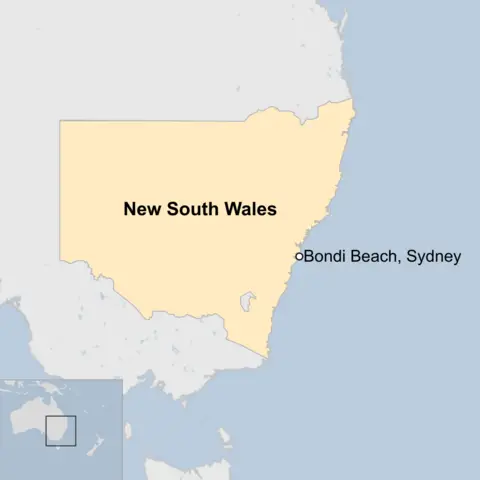
What happened?
New South Wales (NSW) police responded to reports of gunfire at around 18:47 local time (07:47 GMT), with video showing hundreds of people fleeing from the coastline.
In their initial statement posted on X, NSW Police urged people at the scene to take shelter and other members of the public to avoid the area.
Around the same time, local media began reporting people "on the ground" in the vicinity of Campbell Parade.
A video verified by the BBC appears to shows two gunmen firing from a small bridge which crosses from the car park on Campbell Parade towards the beach itself.
An event to mark the first day of the Jewish celebration Hanukkah was taking place on Bondi Beach, very close to the bridge where the men were firing from. More than 1,000 were in attendance.
Premier Minns also paid tribute to a man filmed wrestling a gun from one of the attackers.
"That man is a genuine hero, and I've got no doubt there are many, many people alive tonight as a result of his bravery," Minns said at a press conference.
In the video, the man is seen sneaking up on the attacker, before grabbing him in a bear hug.
The now-disarmed man then retreats back towards the bridge, where the other attacker is still firing from.
As the video continues, another man appears to be injured and flees the scene, as a policeman arrives behind the attackers and opens fire at them.
A separate video, also verified, shows several policemen on the same bridge. One appears to be administering CPR to a motionless man as someone shouts "he's dead, he's dead".
How many people were killed and injured?

 Getty Images
Getty ImagesApart from police confirming one gunman as dead, details on who has been killed and injured are sparse.
Twelve people including one of the armed men have been confirmed dead by police. Another gunman is said to be in a critical condition.
Officials say 29 other people were taken to hospital, and two officers were also shot during the incident.
One eyewitness, Barry, was attending the Hanukkah event on Bondi when with his children when he heard gunshots.
He told the BBC he saw two men on a bridge shooting towards the crowd.
He said there were bodies on the ground. He and his children were able to escape with a friend in a car, he added.
What is the latest?

 Getty Images
Getty ImagesPolice have declared Saturday's shooting a terror attack.
An exclusion zone has been set up around the scene as police use specialist equipment to check improvised explosive devices (IEDs) found in a car linked to the dead gunman, and police are still urging the public to avoid the area."
"No stone will be left unturned" in the investigation, New South Wales Police Commissioner Mal Lanyon said.
He said police would not release any information about the gunmen at this time, and urged for calm while police carry out their duties, adding that this was "not a time for retribution".
Police said they cannot confirm if there was a third gunman involved or if there was anyone else involved in the attack, but enquires are ongoing.
During a televised address, Australian Prime Minister Anthony Albanese called the Bondi Beach shooting "an act of evil antisemitism, terrorism that has struck the heart of our nation".
"We have seen Australians today run towards dangers in order to help others. These Australians are heroes and their bravery has saved lives", he added.
Woman dies and man critically ill after house fire

 BBC
BBCA 25-year-old woman has been found dead after a house fire which has left a man, aged in his 60s, critically ill.
The blaze was reported at about 23:00 GMT on Saturday at an address in Northlands Road in Totton, Hampshire.
The roof and an upstairs dormer window of the property were severely damaged by fire.
An investigation has been launched by police and fire officers.
In a statement, Hampshire and Isle of Wight Constabulary said: "Sadly, despite the very best efforts of the emergency services, a 25-year-old woman was pronounced deceased at the scene. Her next of kin have been notified.
"A man in his 60s, who was also inside the property at the time, has been taken to hospital and is in a life-threatening condition.
"We would ask that people respect the family's privacy at this unimaginably difficult time and refrain from any speculation."
Police said officers would remain at the scene for the rest of Sunday.
You can follow BBC Hampshire & Isle of Wight on Facebook, X (Twitter), or Instagram.
Ghanaian students at UK universities face deportation amid funding crisis
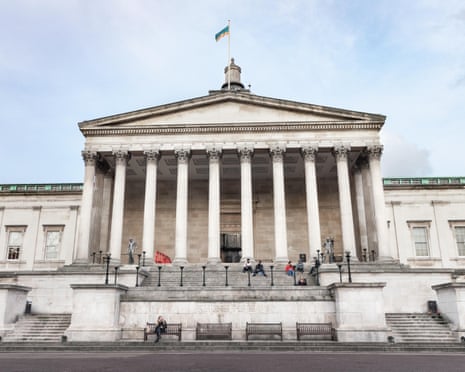
Students from Ghana at UK universities say they are in danger of being deported after being stranded by their own government without promised scholarships or tuition fee payments.
The group representing more than 100 doctoral students has petitioned Downing Street and Keir Starmer asking for help to persuade the Ghanaian government to pay the backlog of tuition fees and living allowances running into millions of pounds.
Prince Komla Bansah, the president of the group of students, said some have already been deported by the Home Office after their universities withdraw their registrations for non-payment; while others have been evicted from their accommodation or forced to borrow money to survive.
Bansah said: “For most of these students, I don’t know how they survive. Some of them may be working part-time but it’s very hard to do that while studying for a PhD. From what I can gather from our meetings with the students, a lot of them are in debt and getting loans from back home.”
The petition sent to Downing Street says the funding crisis “is so severe that some colleagues are now facing court cases over unpaid rent. To survive, some have had to depend on food banks because they have no money to feed themselves.”
The students affected are at institutions spread across Britain, including University College London, Robert Gordon University in Aberdeen and the universities of Nottingham, Bradford, Warwick, Lincoln and Liverpool.
Ghanaian authorities said that after President John Mahama’s new administration was sworn in last January, it found inherited debts to about 110 institutions in the UK worth an estimated £32m.
Alex Kwaku Asafo-Agyei, the registrar of the Ghana scholarship secretariat in Accra, said an audit of all scholarships given out by the last administration was continuing while a pause had been placed on new scholarships to the UK.
After his appointment in April, Asafo-Agyei said he went on a “fact-finding mission” to the UK and drew up instalment plans with some of the institutions. But he said some of the universities had since rescinded the agreements.
Asafo-Agyei said Ghana had made “significant payments to our partner institutions in the UK and we have agreed to amicably resolve these issues so that our students are not at a loss”. He added that he was “not at liberty to make such disclosures without express approval from above”.
Asafo-Agyei declined to answer how much of the debt has been paid so far.
About 30 of the Ghanian PhD students said the scholarship secretariat had failed to pay their tuition fees since 2024, with some barred from officially graduating, submitting work or accessing their university’s facilities.
Others have missed support payments for more than three years, while Bansah said the government had also failed to renew its letters of support for scholarship holders already studying in the UK.
Bansah said: “We all agree that the new government only came into power in January but the reality is that the government was already aware of the situation and it still hasn’t made the payments.
“Meanwhile, there is evidence that they have still awarded foreign scholarships, so why are they still awarding scholarships when they know there is still a major problem with the UK?”
Earlier this year, more than 180 Ghanaian students at the University of Memphis in the US complained about missing payments from the secretariat.
Students from other countries have also struggled with the same problems. In 2020, Nigerian students protested outside their high commission in London after some students lost course places. More recently, hundreds of South African students in Russia faced eviction from campus after delays in receiving government scholarships.
What We Know About the American Troops in Syria

© John Moore/Getty Images
Zelensky Offers Compromise Before Latest Round of Peace Plan Talks

© Odd Andersen/Agence France-Presse — Getty Images
New York City Gets Its First Big Snowfall of the Season

© Janice Chung for The New York Times
Rodney Brooks, the Godfather of Modern Robotics, Says the Field Has Lost Its Way

© Aaron Wojack for The New York Times
智利将变天?极右翼候选人在总统选举第二轮中占据优势 - RFI - 法国国际广播电台

据本台法语部报道,近一千六百万智利人被呼吁在12月14日星期日,参加总统选举的第二轮投票。尽管在11月16日的第一轮投票中领先,但民意调查显示,共产主义候选人珍妮特·哈拉(Jeannette Jara) 预计将输给极右翼候选人 何塞·安东尼奥·卡斯特(José Antonio Kast)。卡斯特得到了右翼联盟的支持,其竞选言论集中在秩序和安全问题上。
本台法语部报道首先提问:谁将接替左翼总统加夫列尔·博里奇(Gabriel Boric)在智利的职位?在这个高度两极分化的第二轮总统选举中,共产主义候选人珍妮特·哈拉(Jeannette Jara)——她继承了现任执政联盟的遗产——将面对极右翼候选人何塞·安东尼奥·卡斯特( José Antonio Kast)。尽管哈拉在11月16日的第一轮中领先,但由于右翼联合起来支持她的对手,她被认为将落败。卡斯特的竞选活动集中在安全问题上,而这正是智利人最关心的问题。
自从投身于竞选拉莫内达宫(总统府)以来,卡斯特一直承诺打击移民和犯罪。在他12月11日星期四的最后一次竞选演讲中,他再次暗示,如果当选,将回归“秩序与安全”。最近,他还敦促居住在智利的30多万无证移民在第二轮投票前离开该国,这在与秘鲁的边境引发了剧烈紧张。
与卡斯特对垒的珍妮特·哈拉则向选民提供了完全不同的前景:尽管她也承诺正面解决安全和移民问题——此外还有改善社会保障和提高最低工资——但她打算以完全不同的方式行事。在移民问题上,这位左翼候选人希望建立一个在智利生活的外国人的生物识别登记系统,并对那些没有居留许可的人进行“有限的合法化”。
极右翼的卡斯特“体现了长期的秩序与安全”
报道续称,如果民意调查预测成真,卡斯特的当选将标志着一个声称继承了独裁者奥古斯托·皮诺切特遗产的极度保守右翼重新在圣地亚哥掌权。社会学家斯蒂芬妮·阿连达(Stéphanie Alenda)对此现象提供了几种解释。
首先,这位研究员——她也是圣地亚哥安德烈斯·贝洛大学(Andrés Bello University)的教授和拉丁美洲政治危机研究米莱尼奥中心的主任——对本台法语部指出:“卡斯特的受欢迎程度并非源于大多数智利人变成了皮诺切特主义者,而是因为他体现了长期的秩序与安全。而且,他已经放弃了对皮诺切特政权的明确辩护,就像他以前一些在道德上极度保守的立场一样。”
斯蒂芬妮·阿连达接着说:“其中一个解释因素在于,他代表了对左翼及其在短期内令人失望的经济和安全结果的惩罚性投票,或者说,面对极高的社会期望,左翼在这方面沟通得非常糟糕。”
她最后总结道:“智利政治背景最近的特点是围绕安全、移民和经济不安全等问题存在强烈担忧,卡斯特围绕这些问题构建了他的竞选活动。结果是:他成功地吸引了温和或摇摆不定的选民,从而获得了非意识形态的选票。”
泰柬边境冲突升温 50万人流离失所
泰国柬埔寨边境爆发新一轮冲突,已导致约50万人逃离家园。这场冲突的根源是一段延续数十年的边界争端,两国都声称拥有古寺柏威夏寺及其周边土地主权。此次最新冲突始于始于泰国指控柬埔寨军队向泰军开火,两国之间的战斗仍在持续。
民主党今解散 杨森称象征香港倒退至专制 仍望北京重新开放地推「一国两制」 - RFI - 法国国际广播电台

香港老牌政党民主党今(14日)午召开特别会员大会,在九成七票数支持下,通过解散及进行清盘,意味成立31年的民主党走入历史。创党副主席杨森直言,民主党的解散,象征香港由一个自由的社会倒退至一个专制的社会,反映「一国两制」正处於转折点和低点,期望这方针日後有机会重新检验,重新转向较为开放。
随着民主党的解散,香港由上世纪八十年代引入代议政制後设立的众多民主党派,只馀成立至今39年的香港首个参政组织「民协」(全称为香港民主民生协进会)。该会主张「又倾又砌」,即既透过沟通谈判,亦会透过社会行动去争取权益,但行事却惹来是否同道中人的质疑,例如该会前主席曾加入中方解散立法局(回归前的立法会)後成立的临时立法会;在《港区国安法》实施後更修改会章,订明支持中国宪法、香港《基本法》、《国安法》和香港法律管治的宪制秩序。近年行事转趋低调,早前因应导致160人死亡的大埔宏福苑火灾而打算召开记者会,亦因「有部门通知」而取消,主席和拟出席者被警方国安处召见,後更摆街站支持被指民主倒腿的立法会换届选举,被嘲「民协全党无得选都叫人投票;......辛苦您们了。」
创党历史仅次於民协的民主党,今午以117票赞成、4票弃权的情况下通过解散,末代主席罗健熙表示,该党今天「无奈要划上句号」。他和杨森都不愿意细谈个中压力或个人有否被威胁,只说这是面对「政治形势和压力」、在「没有选择下」的集体决定,是对所有党员最好的决定。
民主回归派亦指香港正在「一国一制」
作为由支持「民主回归派」人士创立的政党要解散,创党副主席兼前议员杨森否认这是民主回归的失败,认为现在只是走了一半,过往由於制度开放地执行,造就了香港的成功;现在是「一国两制」的转折点、低点,但不是完全无希望,亦不是终结,日後若有机会重新检验「一国两制」,向更开放方向发展,香港前途会比现在更好。
他又说,半民主丶全自由下的香港,过去三十年的成功有目共睹,民主派候选人在选举中获六成选民支持,可见民主自由法治已深入民心,特别是年轻人;而在刚过去的立法会换届选举的投票率,「年青一代投票(率)好低(即很低),好低,系历史上一个好低」,反映现时香港正由「一国两制」向着「一国一制」发展,年轻人对社会的投入不再那麽热切,「这是很危险的」,望当局关注和予以重视。他强调,年轻人不光看经济发展,亦十分渴望政治开明、自由、开放、多元化,港人对民主的诉求不会消失,呼吁政府思考。
在民主党有廿年党龄的罗健熙和一众会员对该党要走入历史都感到不拾,罗更直言,各方在代议政制下争论是好事,因为事情可以越辩越明,可惜他们争取全面直选的民主之路仍未走完,缅怀过去活跃的公民社会,事情由下而上,确是美好;但现在是由上而下,少了自发和创意。民主党寄语港人,日後心存善良、诚实、正直,努力过好每一天,守护好自己和身边的人。
另一名创党会员兼前议员李华明,会後更一度落泪,对解散感到不舍,更1料到事态会发展至如斯局面,强调民主党在大是大非议题上,一直与中央政府立场一致,只是在香港议题出现分歧,特别是经过2019年的社会运动,政权以稳定压倒一切,令温和民主派亦难以生存。
经会员大会通过後,民主党的运作今日会结束,但由於该党以公司形式注册和运作,须经清盘才能结束,罗健熙估计,清盘程序须一年内能完成,否则要再召开会员大会再延长决议。至於清盘後馀下的资金,将会悉数捐予工业伤亡权益会。
民主党是香港老牌民主党派,亦是香港回归中国前後的立法会(1997年回归前称为立法局)内第一大党,由 1991年至 2004年间,占有议会 22%至 32%的议席。这地位加上该党党章订明支持「一国两制」,民主党长期以来是北京拉拢或统战的对象,并在前特首曾荫权年代的2010年历史性走入中央政府驻港化表机构的中联办,促成增设超级区议会议席的政改方案。不过,此役被部分同道中人视为「跪低」而令民主党派内进一步分裂。到了2019年,民主党与其他泛民人士积极参与反对修订逃犯条例运动,与北京决裂;在中国领导人习近平的「爱国者治港」政策和《港区国安法》实施下,多个泛民组织相继被迫解散,而民主党在走过31个年头後,亦终於正式走入历史,有人形容为支持香港回归中国後争取落实全面民主政制的终结。
泽连斯基:为和平放弃加入北约的雄心 暗示做好提前大选准备 - RFI - 法国国际广播电台

路透社柏林/基辅周六(12月14日)消息,乌克兰总统泽连斯基表示,作为结束与俄罗斯战争的妥协方案,乌克兰已放弃加入北约(NATO)军事联盟的雄心,以换取西方的安全保障。他是在前往柏林与美国特使会谈前夕做出上述表态的。另外,泽连斯基已告知乌最高拉达(议会)的议员们做好应对不久后可能举行选举的预案。
路透社指出,此举标志着乌克兰的一个重大转变。乌克兰一直致力于加入北约,将其作为抵御俄罗斯袭击的保障,并且这一愿望已写入其宪法。此举也满足了俄罗斯的一项战争目标,尽管基辅迄今仍坚持不向莫斯科割让领土。
泽连斯基周日表示,以美国、欧洲和其他合作伙伴的安全保障来代替北约成员国身份,是乌克兰方面做出的妥协。
他在 WhatsApp 聊天中回答记者提问时说:“从一开始,乌克兰的愿望就是加入北约,这是真正的安全保障。但美国和欧洲的一些伙伴不支持这个方向。”
泽连斯基说:“因此,今天,乌克兰与美国之间的双边安全保障、美国向我们提供的类似《北约宪章》第五条的保障,以及来自欧洲同僚和加拿大、日本等其他国家的安全保障——这是防止俄罗斯再次入侵的一个机会。”
他表示:“这已经是我们方面的妥协了”,并补充说,这些安全保障应该是具有法律约束力的。
俄罗斯总统普京曾多次要求乌克兰正式放弃其加入北约的雄心,并要求其从基辅仍控制的约10%的顿巴斯地区撤军。莫斯科还表示,乌克兰必须是一个中立国家,且北约部队不得驻扎在乌克兰。
俄罗斯消息人士今年早些时候表示,普京希望主要西方大国做出“书面”承诺,不向东扩大由美国领导的北约联盟——这暗指正式排除乌克兰、格鲁吉亚、摩尔多瓦和其他前苏联加盟共和国的成员资格。
泽连斯基早些时候呼吁实现“有尊严的”和平,并要求俄罗斯保证不会再次攻击乌克兰。他正准备在柏林会见美国特使和欧洲盟友,以结束欧洲自第二次世界大战以来最致命的冲突。
在面临美国总统特朗普要求签署一项最初支持莫斯科要求的和平协议的压力下,泽连斯基指责俄罗斯通过对城市、以及乌克兰电力和供水设施进行致命轰炸来拖延战争。
尽管周日和周一会谈的具体安排尚未公开,但一位美国官员表示,特朗普的特使维特科夫和女婿库什纳前往德国参加涉及乌克兰人和欧洲人的会谈。
选择派遣一直主导美国和平提案中与乌克兰和俄罗斯谈判的维特科夫,似乎表明华盛顿看到了在俄罗斯2022年入侵近四年后取得进展的机会。
泽连斯基表示,乌克兰、欧洲国家和美国正在研究一项20点计划,该计划最终将实现停火。他说基辅没有与俄罗斯进行直接会谈。
泽连斯基表示,沿着当前前线停火将是一个公平的选择。
德国总理默茨将于周一在德国首都主持泽连斯基和欧洲领导人的峰会,这是欧洲盟友对乌克兰领导人一系列公开支持行动中的最新一次。
“关键时刻”
英国、法国和德国一直在努力完善美国的提案。上月披露的一份草案呼吁基辅割让更多领土,放弃加入北约的雄心,并接受对其武装部队的限制。
欧洲盟友将此描述为可能塑造乌克兰未来的“关键时刻”,并试图通过利用被冻结的俄罗斯中央银行资产来资助基辅的军事和民用预算,从而巩固乌克兰的财政状况。
普京在12月初主持了与维特科夫和库什纳的会谈,克里姆林宫称赞会谈“富有建设性”,尽管没有取得重大突破。
泽连斯基表示,俄罗斯对乌克兰大片地区的能源、供暖和供水设施进行打击后,仍有数十万人断电。他发布了燃烧和被毁建筑物的照片。
他说:“俄罗斯正在拖延战争,并试图对我们的人民造成尽可能多的伤害。”
俄罗斯在2022年对乌克兰的全面入侵导致与西方的关系急剧恶化,并引发了北约和欧洲领导人关于普京不会就此罢休的警告。
北约秘书长吕特周四在柏林的一次演讲中表示,北约应该“为我们的祖父母或曾祖父母所经历的战争规模做好准备”,并断言“我们是俄罗斯的下一个目标”。
克里姆林宫多次否认此类说法。
克里姆林宫发言人佩斯科夫周日对国家电视台记者帕维尔·扎鲁宾(Pavel Zarubin)表示:“这似乎是一个设法忘记第二次世界大战实际情况的那一代代表所说的话。”
佩斯科夫补充说:“他们缺乏理解,不幸的是,吕特先生发表如此不负责任的言论,根本不明白他在说什么。”
泽连斯基暗示乌克兰或提前大选
另值得注意的是,乌克兰总统泽连斯基已告知乌最高拉达(议会)的议员们做好应对不久后可能举行选举的预案。
据乌克兰国家通讯社报道,泽连斯基星期天(12月14日)说:“最重要的是,我不会固守总统职位,我认为乌克兰应准备好应对任何变化。”他说,已请求伙伴帮助解决选举安全保障问题,他还告知乌最高拉达议员做好不久后可能举行选举的预案。
泽连斯基说,他已收到美国和特朗普总统关于乌克兰总统选举的“信号”,“不论这些信号仅来自美国,还是也来自俄罗斯,我目前不想评价”。
'It was pandemonium': Jewish community targeted in Australia's deadliest shooting in decades

 Getty
GettyThe first day of Hanukkah was a sweltering one in Sydney - a perfect afternoon to spend at Australia's most iconic beach.
More than 1,000 people were enjoying a festival marking the occasion at a grassy stretch in Bondi: kids careened around in facepaint, crowds snaked between food trucks, and many enjoyed live entertainment as they soaked up the last rays of sunshine.
Then, just before 7pm local time, shots rang out.
From a small footbridge - just metres from a children's playground - gunmen fired upon the fenced-in crowds. A car full of improvised bombs was parked nearby, though they never went off.
One attendee, who identified himself only as Barry, described watching people around him get shot as hundreds of beach-goers began screaming and running through the park to get away from the attack.
"It was pandemonium and chaos," he told the BBC.
One video showed a man - dubbed a "genuine hero" by state officials - leaping out from behind a parked car to wrestle a gun from one of the attackers and push him away.
"It was simply an unbelievable scene… in today's day and age, that families and kids on Bondi could be completely mowed down for being Jewish," Barry said.

 Getty
GettyAt least 11 people have died and more than two dozen are injured, including a child. One gunman was also killed by police, another is in hospital in a critical condition, and police say they're investigating whether a third person helped stage the attack.
This is an unfamiliar, and devastating, shock for Australia - the deadliest shooting in this country since the Port Arthur massacre in 1996.
That attack, which killed 35 people, was a turning point, famously prompting the government to introduce some of the world's strictest gun control measures.
We've only had a handful of mass shootings since then, most of them horrific acts of domestic violence - not public attacks like today.
Swiftly declared a terrorist attack by police, it comes amid a rise in antisemitic attacks in Australia since the 7 October Hamas attack on Israel and Israel's subsequent offensive on Gaza.

 Getty
Getty
 Getty Images
Getty ImagesPrime Minister Anthony Albanese called it an "act of evil antisemitism" and a "vile act of violence and hate".
But he's been accused by some - including Israel's Prime Minister Benjamin Netanyahu - of failing to address the upward trend of antisemitism here.
"The Australian government, which received countless warning signs, must come to its senses!" Israel's Foreign Minister Gideon Sa'ar wrote on X.
Alex Ryvchin, co-CEO of the Executive Council of Australian Jewry, told Sky News Sunday night that the "worst fears" of the Jewish community had been realised.
"It's been bubbling under the surface for a long time, and now it's actually happened."
In a statement, the Australia Jewish Association's Robert Gregory said many Jews would tonight be pondering whether they have a future in Australia.
"To be confronted with this horrific act of antisemitic violence during the Jewish festival of light and hope is shattering. In moments like this, we hold each other close," the Jewish Council of Australia said in a statement.

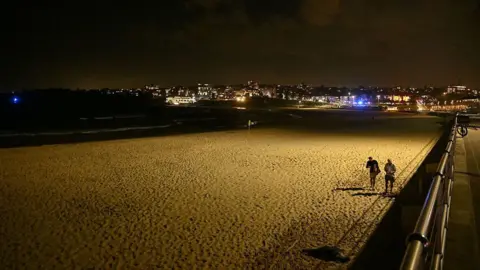 Getty
GettyThere's a lot police can't - or won't - say yet. But they have declared this was a terrorist attack.
Who the gunmen are - how many of them even - and their motive is still unclear. They said one of the attackers was known to police, but wasn't on their radar for anything like this.
Officials wouldn't answer any questions about those who died either, out of respect for families who are still being notified.
"It's too early to give that information," was the most frequent refrain uttered at a press conference late on Sunday night.
But where NSW Police Commissioner Mal Lanyon couldn't offer answers, he tried instead to offer reassurance. Police are throwing everything at this investigation, he said.
He urged the community to remain calm, and avoid spreading misinformation online - including speculating on the victims and perpetrators of the attack.
"I want to make sure that there is no retribution," Commissioner Lanyon said.
Local politicians have also asked people not to share graphic footage from the attack on social media.
In the aftermath of the shooting, sirens were ringing through the city and the area surrounding Bondi swarmed with police cars, helicopters circling above.
There we found Fin Green, who was on FaceTime with his family in the UK when he saw the shooting unfolding outside his window. Unsure what was happening, he hid in his wardrobe for an hour and a half, until he felt it was safe to go out.
Danny Clayton, a broadcast journalist who was at the beach and witnessed the events from the Bondi Pavilion, said some people crashed their cars as they attempted to flee.
Many others in the area had similar stories. Restaurant worker William Doliente Petty said he was serving someone when he heard the gunshots. "The whole shop just stood up and we ran into the back exit."
Australia prides itself on being a merry, safe country and Bondi Beach has long been a symbol of that. But that image has been shattered and residents are in disbelief.
Sunday's attack also came less than two years after another nearby tragedy. In April last year, a deadly mass stabbing attack took place at nearby Bondi Junction. Shocked, many then uttered the same words we've heard over and over today too: "This sort of thing just doesn't happen here".
Additional reporting by Katy Watson and Tabby Wilson.
King 'appalled and saddened' by Bondi attack on Jewish community

 PA Media
PA MediaThe attack targeting the Jewish community at a Hanukkah event in Australia is "sickening", Sir Keir Starmer has said.
At least 11 people were killed in the shooting at Bondi Beach on Sunday and a further 29 taken to hospital, according to police.
In a statement on X, the UK prime minister said: "The United Kingdom will always stand with Australia and the Jewish community." He added that the government was working with Community Security Trust, a Jewish security organisation, on the policing of Hanukkah events in the UK.
The Metropolitan Police said it was increasing its "police presence, carrying out additional community patrols and engaging with the Jewish community to understand what more we can do".
"It is an awful reality that Jewish communities across the world continue to face a higher level of threat," the force said in a statement.
"At a time when London's Jewish communities are coming together to begin the celebration of Hanukkah, we know this attack will be the cause of not just terrible upset but also significant heightened concern about safety."
In October, two people were killed in an attack at a synagogue in Manchester on Yom Kippur, the holiest day in the Jewish religious calendar.
On Sunday, the UK's Jewish Leadership Council (JLC) called on the police and government to protect events celebrating Hanukkah which begins this evening and lasts for eight days.
Hanukkah, also known as Chanukah, is a festival of light usually observed in December.
"We are devastated and angered that in Sydney, Jews appear to have been targeted once again for being Jewish," the JLC said in a statement.
"We know that such hatred also exists in this country, as we are still reeling from the attack on a synagogue in Manchester on Yom Kippur.
"As we prepare to celebrate Chanukah over the next eight nights, we call on government and law enforcement to work with our community to protect Jewish life in the UK and ensure that events this week can go ahead safely. We must not let hatred extinguish the festival of light."
Don’t let your device tell you what to think, Grand Theft Auto mastermind warns

 Rockstar Games
Rockstar GamesDan Houser was one of the masterminds behind revolutionary video game series Grand Theft Auto.
Now, after leaving Rockstar Games and launching his own company, he's released a debut novel about a very different type of game.
A Better Paradise is a dystopian vision of the near future in which an AI-led computer game goes rogue.
Set in a polarised world, it finds Mark Tyburn attempting to create a virtual haven for people to find sanctuary and reconnect within themselves against an all-consuming social media hellscape.
But it all goes wrong when it ends up unleashing a mysterious, sentient AI bot named NigelDave into society - "a hyper-intelligence built by humans" - flaws included.
Readers get to see his thought processes as he struggles with "infinite knowledge and zero wisdom".
"What would an incredibly precocious child, who remembers everything he ever thought - because computers don't forget things - feel like when he started talking?" Houser says.

 Getty Images
Getty ImagesWritten before ChatGPT
It feels a bit like A Better Paradise predicted the future.
First released as a podcast, the book comes as AI's continued boom means the sector's big seven companies are now collectively worth more than China's economy.
But Houser says he began writing the book "a good year" before OpenAI's ChatGPT went live to the masses in 2022, complete with a logo eerily similar to his fictional creation.
Instead, it was humanity's technological dependency during Covid - at a scale he'd underestimated - that inspired his thinking.
In his novel - which sometimes feels monologue-heavy - Houser envisions a hyper-digital, alienating world where people retreat from deepening political problems into a spiral of social media and generative AI.


Enter CEO of Tyburn Industria, Mark, who dreams of building the Ark, an immersive gaming experience users can enter in order to reconnect with themselves. It generates a world and mission tailored to each player's innermost wants and needs.
But during testing, the Ark becomes a Pandora's box of addiction. Some players find joy; others encounter terror. One even reconnects with his dead sister.
Meanwhile, a rogue AI bot named NigelDave slips into the real world, controlling minds and engineering realities no one can control.
Mined for advertising, people are left wondering if their thoughts are genuine. Everything is tracked, and nothing is secure. As climate emergencies intensify, society falls to pockets of civil war.
The only way to escape is to "drift"- which means hiding from a thousand algorithms by living off-grid, constantly moving and suppressing maddening paranoia that your thoughts are not your own.
Mirroring our world
To the reader, NigelDave feels like a nightmare ChatGPT gone wrong.
The AI tool recently reached 800 million weekly active users, according to boss Sam Altman, and Houser believes some people are becoming dependent on the technology's affirming "human veneer".
Microsoft's head of AI Mustafa Suleyman has warned of a rise in AI psychosis - a non-clinical term describing incidents where people increasingly rely on chatbots like Claude, Grok and ChatGPT and become convinced that something imaginary has become real.
In some cases, the chatbot fuels grandiose fantasies about future opportunities. In others, it presents in a romantic connection. More troubling are reports of parents saying bots have encouraged their children to kill themselves.
In response to the increased scrutiny, ChatGPT creator OpenAI recently tightened its welfare protocols, with updates designed to ensure its chatbot responds "safely and empathetically to potential signs of delusion or mania".

 Bloomberg via Getty Images
Bloomberg via Getty ImagesThe dizzying algorithm-fuelled society in which NigelDave is unleashed mirrors ours too.
Parents worry about exposing their children to false information or harmful content. Last year national police chiefs described the "quite terrifying" misogynistic radicalisation of boys and young men. And in 2014 Facebook admitted manipulating the news feeds of nearly 700,000 users without their consent to manage the emotions they were exposed to.
"As a parent, you always worry about anything that you expose your kids to that is going to either give them false information or simply bombard them with too much information," Houser says.
But is it bold for a video game creator to be warning of these dangers - given the long history of video games themselves being accused of making young people violent?
Houser insists there's a difference.
"We always had the data about game violence, and it was very clear: as people played more video games, youth violence went down.
"Whatever people were claiming, we knew the opposite was true."

 Getty Images
Getty ImagesPsychology professor and game violence researcher Pete Etchells says numerous studies have shown "no meaningful effect of playing violent games on aggression".
AI models and social media are another matter - a "new paradigm" in altering behaviour that gaming never threatened, according to Matt Navarra, social media consultant and author of the Geekout Newsletter.
He says dismissing concerns as a GTA-style moral panic "understates what is changing".
"We're talking about external systems that can potentially shape people's beliefs or manipulate attention, personalised experiences, nudge behaviour or even influence identity and emotional states."
Rockstar freedom
Could Houser have pushed forward with A Better Paradise at Rockstar? "I don't know if I would have had the bandwidth to think about it," he tells me.
He's previously described the fatigue of managing vast open-world sandbox games like Red Dead Redemption and GTA as playing a role in his departure.
The goal with his book was to create "something truly different in this era of crazy media saturation".

 Rockstar Games
Rockstar GamesSo where next? He's already writing the second instalment of the series, and plans are under way to develop a video game, for which he promises the visuals are ground-breaking.
A key message, he says, is to not let your device - or AI - "tell you what to think". Otherwise, Houser argues, "you're giving up control to your phone".
His biggest fear, as creator of worlds, is losing imagination because of the endless torrent of algorithms. Sometimes after scrolling for hours, he realises: "I've not had an idea all day".
"If you go offline for a bit - sometimes I make myself go for a walk with no phone, you start to have ideas.
"A human is better thinking than not," he says. "Thinking is a privilege."
If you've been affected by issues involving suicide or feelings of despair, details of organisations offering advice and support for people in the UK are available from BBC Action Line. Help and support outside the UK can be found at Befrienders Worldwide.
Little Foot hominin fossil may be new species of human ancestor

Little Foot, one of the world’s most complete hominin fossils, may be a new species of human ancestor, according to research that raises questions about our evolutionary past.
Publicly unveiled in 2017, Little Foot is the most complete Australopithecus skeleton ever found. The foot bones that lend the fossil its name were first discovered in South Africa 1994, leading to a painstaking excavation over 20 years in the Sterkfontein cave system.
Prof Ronald Clarke, a paleoanthropologist at the University of the Witwatersrand, who led the team that excavated the skeleton, attributed Little Foot to the species Australopithecus prometheus. Others believed it was Australopithecus africanus, a species first described in 1925 and which had previously been found in the same cave system.
Australopithecus – meaning “southern ape”– was a group of hominins that existed in Africa as early as 4.2m years ago.
But a new study led by Australian researchers, published in the American Journal of Biological Anthropology, has found that Little Foot’s traits differ from both species, raising a third possibility.
“We think it is a formerly unknown, unsampled species of human ancestor,” said Dr Jesse Martin, an adjunct at La Trobe University in Melbourne, who led the research.
“It doesn’t look like Australopithecus prometheus … but it also doesn’t look like all of the africanus to come out of Sterkfontein.”
Martin, also a postdoctoral research fellow at the University of Cambridge, added: “This thing will be part of a lineage of hominins, so it’s possible that we have not just a point in our human family tree that we hadn’t discovered before, but an entire limb of that tree.”
Martin said Clarke was “one of the only people to maintain there were two species of hominin at Sterkfontein”, and had been “proven to be correct” in that regard.
“Where [Clarke] and I depart is I would argue one is definitely not prometheus,” he said.
The researchers identified key differences distinguishing Little Foot from Australopithecus africanus, including a longer nuchal plane – a region at the back of the skull.
“The bottom back of the skull is supposed to be fairly conserved in human evolution, which is to say it doesn’t change that rapidly,” Martin said. “If you find differences between things in the base of the cranium … those differences are more likely to represent different species, because they just don’t change readily, evolutionarily speaking. All of the differences we’ve found are in that region.
“To find evidence hiding in plain sight at Sterkfontain of an entirely new species is kind of remarkable and counterintuitive,” Martin added, given “it is the most complete human ancestral fossil in the record”.
“We should be able to figure out where it sits in the human family tree.”
The study’s authors have not formally reclassified Little Foot, suggesting: “It is more appropriate that a new species be named by the research team that has spent more than two decades excavating and analysing the remarkable Little Foot specimen. We hope they will view our suggestion in this regard as well-intentioned advice.”
There has also been disagreement among scientists about Little Foot’s age. The fossil skeleton has been dated as 3.67m years old, but other scientists have suggested Little Foot cannot be older than 2.8m years.
Prof Ronald Clarke, who discovered the skeleton, has been contacted for comment.
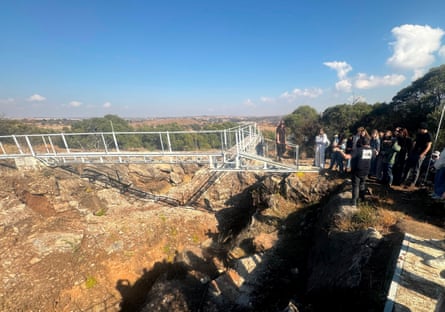
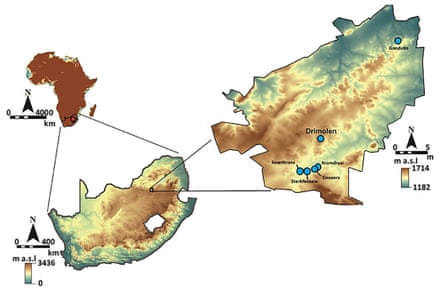
Chile Poised for Right-Wing Victory as Crime Fears Sweep Latin America

© Sara Wayra for The New York Times
悉尼海滩恐袭致12死:多国领袖震惊发声 以色列亦批澳政府
2025-12-14T13:58:21.313Z

(德国之声中文网)当地时间周日(12月14日)傍晚,在澳大利亚邦迪海滩(Bondi Beach)举行的犹太节日活动“海边的光明节”上发生枪击事件,造成至少12人死亡、近30人受伤。澳大利亚警方和官员将此事件定性为恐怖袭击。
新南威尔士州警察总监马尔·兰扬(Mal Lanyon)在新闻发布会上表示,一名嫌疑枪手被当场击毙,另一名情况危急,正在抢救中。已有至少29人被送往医院接受治疗,其中包括两名警察。
兰扬还透露,警方正在调查是否有第三名枪手涉案,同时排爆小组正处理多枚疑似简易爆炸装置。 澳大利亚高级情报官员迈克·伯吉斯(Mike Burgess)表示,其中一名嫌疑人此前已在当局监控名单中,但并未被视为迫切威胁。

澳方召开紧急会议
此次枪击事件是自2023年10月以色列与哈马斯战争爆发以来,澳大利亚国内一系列反犹事件中最为严重的一起,之前已有犹太教堂、建筑及车辆遭到攻击。
澳大利亚一向被视为全球最安全的国家之一,大规模枪击案极为罕见。这是自1996年塔斯马尼亚州旅游景点发生35人死亡的枪击案以来,澳大利亚最严重的类似事件。
澳洲总理阿尔巴尼斯召集国家安全委员会紧急会议,并谴责此次袭击,称“这场袭击所展现的邪恶令人难以想象”。“这是一起专门针对澳大利亚犹太人的蓄意袭击,发生在光明节的第一天——原本应是一个充满喜悦与信仰的日子。”阿尔巴尼斯补充道:“在这个国家的黑暗时刻,警方和安全机构正全力追查所有与这场暴行有关的人员。”
混乱之中出英雄
有目击者称,袭击持续约10分钟,数百人在邦迪海滩和附近街道、公园中惊慌逃命。警方表示,仅光明节活动就吸引了约1000人参加。
社交平台X上传出多段视频,显示人群尖叫奔逃、警笛四起。一段视频中,一名身穿白衬衫的男子冲向一名穿深色上衣、手持步枪的男子。他从背后将对方扑倒,徒手夺下其步枪,随后将枪口反指向该男子。视频随后显示,身穿深色上衣的男子站立不稳,向后退向一座桥的方向,而桥上当时还有另一名枪手。与此同时,这名旁观者将枪放在地上。
路透社通过多段经过核实的辅助影像确认了这段视频的真实性,这些画面显示的是同一批男子。路透社还核实,视频中出现的持枪者,与其他经核实影像中被警方包围的嫌疑人是同一批人,依据是他们的服装特征一致。
这段记录路人英勇行为的视频迅速在社交媒体上传播开来,许多人称赞该男子的勇气。目前,该男子的身份尚未公布。新南威尔士州州长克里斯·明斯(Chris Minns)表示,这是他“见过最令人难以置信的场面”。他说:“一名男子走向一名刚刚向民众开枪的枪手,独自一人将其缴械,冒着生命危险,拯救了无数人的生命。”
以色列政府公开批评
恐袭事件发生后,以色列总统艾萨克·赫尔佐格(Isaac Herzog)表示,那些到海滩点燃光明节第一支蜡烛的犹太人,遭到了“卑劣恐怖分子”的袭击。
以色列外交部长吉迪恩·萨尔(Gideon Saar)对枪击事件表示震惊,并指责澳大利亚政府在多次警告后依然“未能警醒”。 他说:“这是过去两年来澳大利亚街头反犹情绪泛滥的直接后果,‘全球化起义’(Globalise the Intifada)等煽动性口号如今变成了现实。”
多国领导人表态
德国总理梅尔茨(Friedrich Merz, 又译“默茨”)称此次恐袭事件令他“震惊得无言以对”。他在社交平台 X 上发文表示:“这是对我们共同价值观的攻击。我们必须制止反犹主义——无论是在德国,还是在世界各地。”
欧盟委员会主席乌尔苏拉·冯德莱恩(Ursula von der Leyen)也表示 “对邦迪海滩的悲剧性袭击深感震惊”,“我向遇难者的家属和亲人致以诚挚慰问”。她在X平台上写道:“欧洲与澳大利亚以及全球犹太社群站在一起。我们团结一致,反对暴力、反犹主义与仇恨。”
英国首相斯塔默表示,针对悉尼犹太人聚会的致命袭击“令人作呕”,并强调:“英国将始终与澳大利亚以及犹太社群站在一起。”
法国总统马克龙谴责这起袭击,并誓言法国将“毫不懈怠地打击反犹仇恨”。
意大利总理梅洛尼在X平台上表示,她对“来自悉尼的悲惨消息深感悲痛”。她补充说:“意大利再次坚定谴责一切形式的暴力和反犹主义,并向遇难者表示哀悼。”
乌克兰总统泽连斯基在X平台上表示,乌克兰“在面对这起发生在悉尼邦迪海滩、针对犹太社区的残忍恐怖袭击时,与澳大利亚站在一起”。他强调:“恐怖与仇恨绝不能得逞——必须在任何地方、任何时候将其击败。”
美国国务卿鲁比奥表示,美国“强烈谴责”邦迪海滩发生的袭击事件。他在X平台上写道:“反犹主义在这个世界上没有立足之地。我们为这起可怕袭击的受害者、犹太社群以及澳大利亚人民祈祷。”
DW中文有Instagram!欢迎搜寻dw.chinese,看更多深入浅出的图文与影音报道。
© 2025年德国之声版权声明:本文所有内容受到著作权法保护,如无德国之声特别授权,不得擅自使用。任何不当行为都将导致追偿,并受到刑事追究。
渝昆高铁24.8公里最长隧道贯通
位于云南昭通的渝昆高铁最长隧道贯通,渝昆高铁云南段进入最后冲刺阶段。全线建成通车后,重庆到昆明的行车时间将压缩至约两个半小时。
《光明日报》星期天(12月14日)第三版刊,渝昆高铁全线最长隧道——彝良隧道,于星期三(10日)安全贯通,为全线建成通车打下坚实基础。
彝良隧道位于云南省昭通市境内,全长24.8公里,设计时速350公里,最大埋深920米,采用双洞单线的设计形式。隧道穿越乌蒙山腹地,这里山高谷深,地质构造复杂多变,为一级高风险隧道,建设难度极大。
据新华社报道,彝良隧道是渝昆高铁重难点控制性工程,科研攻关团队已获得省部级工法三项、国家专利七项,申报国际专利一项,为中国长大高铁隧道施工积累了宝贵经验。
随着彝良隧道的贯通,渝昆高铁云南境内隧道贯通已达96%,53座隧道即将全部贯通。
目前,渝昆高铁云南段全面进入冲刺阶段,施工人员正全力推进无砟轨道施工和站后工程建设。
据悉,渝昆高铁全长约700公里,其中云南段长388.6公里,是云南省内首条时速350公里的高速铁路。
据此前报道,渝昆高铁的重庆段已于去年9月开通运营。
渝昆高铁全线建成通车后,重庆到昆明的行车时间将压缩至约两个半小时。报道称,这对促进成渝地区双城经济圈与滇中城市群之间互联互通,推动沿线地区经济社会高质量发展具有重要意义。
'Person of interest' detained over Brown University shooting, police say

 Reuters
ReutersA person of interest has been detained in connection with a US shooting at Brown University that left two people dead, police said.
Nine others were injured when a gunman opened fire at the university in Providence on Saturday.
Police confirmed on Sunday a person had been detained, and an earlier order for people on the Brown campus and surrounding areas to shelter had been lifted.
Of those injured, medics said one person was in a critical condition, six were "critical but stable" and two others were less severely hurt.
The gunman opened fire in a classroom at around 16:00 local time (21:00 GMT) on Saturday at the Holley engineering building at the eastern end of Brown's campus, according to officials.
The identities of those killed or injured have not yet been released, but Brown University President Christina Paxson told reporters in a press briefing on Saturday that all the victims, including those killed and wounded, were students.
Police had earlier released CCTV footage of a male suspect walking away from the scene wearing all black clothing. Officers said a firearm was not found in a sweep of the building.
Home-Schooled Kids Are Not All Right
No Quick Fix for Our Housing Crisis
美、欧、乌将在柏林就结束俄乌战争举行新一轮协商
2025-12-14T13:07:56.538Z

(德国之声中文网)据美联社报道,乌克兰总统泽连斯基表示,乌克兰、美国和欧洲官员将在柏林举行一系列会晤。泽连斯基周六晚间在乌克兰发表全国讲话时表示:“最重要的是,我将与特朗普总统的特使会面,还将与我们的欧洲伙伴和众多领导人举行会晤,讨论和平的基础,以及一项结束战争的政治协议。”
据报道,美国特使威特科夫(Steve Witkoff)以及特朗普的女婿库什纳(Jared Kushner)周日已抵达柏林。
几个月来,华盛顿方面一直在努力平衡各方的要求,特朗普敦促俄罗斯尽快结束对乌克兰的战争,但同时也对战争的拖延越来越感到恼火。寻求可能的妥协方案遇到了重大障碍,包括对乌克兰东部顿涅茨克地区的控制权问题(该地区大部分被俄罗斯军队占领),以及乌克兰的安全保障问题。
泽连斯基表示:“我们正在努力确保乌克兰的和平是有尊严的,并确保——尤其重要的是——俄罗斯不会再次入侵乌克兰。”
俄罗斯总统普京要求乌克兰从其仍控制的顿涅茨克地区撤军,并放弃加入北约的计划,这是和平的关键条件之一,但基辅方面拒绝了这些要求。
俄罗斯总统外交政策问题顾问乌沙科夫(Yuri Ushakov)警告称,寻求妥协可能需要相当长的时间。他指出,原本已考虑到俄方诉求的美方提案,在乌克兰及其欧洲盟友提出修改意见后被“削弱”了。他在接受媒体采访时说:“美国人知道并理解我们的立场。”
德国总理梅尔茨本周六在慕尼黑表示,普京的目标是“从根本上改变欧洲的边界,在现有边界内恢复昔日的苏联”。他还警告说,“如果乌克兰沦陷了,他(普京)并不会就此收手”。
普京则否认有意恢复苏联或者攻击任何欧洲国家。
乌克兰方面称,过去一周,俄罗斯向乌克兰发射了超过1500架攻击型无人机、近900枚制导航空炸弹和46枚各种类型的导弹。
俄罗斯国防部称,俄罗斯防空部队在周六晚至周日凌晨击落了235架乌克兰无人机。
DW中文有Instagram!欢迎搜寻dw.chinese,看更多深入浅出的图文与影音报道。
© 2025年德国之声版权声明:本文所有内容受到著作权法保护,如无德国之声特别授权,不得擅自使用。任何不当行为都将导致追偿,并受到刑事追究。
What we know so far about Bondi Beach Hanukkah shooting
Twelve people have died - including one gunman - following a shooting at Australia's Bondi Beach which targeted the Jewish community on the first day of Hanukkah.
According to police, at least 12 others have been injured and two officers were shot during the event, which has since been declared a terror attack by officials. The surviving gunman is in a critical condition.
More than 1,000 people were attending an event on the beach celebrating Hanukkah.
Chris Minns, the premier of New South Wales, said: "Our heart bleeds for Australia's Jewish community tonight.
"I can only imagine the pain that they're feeling right now to see their loved ones killed as they celebrate this ancient holiday".
Mass shootings in Australia are very rare, and the attack at Bondi is the deadliest incident in Australia since the Port Arthur massacre in 1996.
Here's what we know so far:
Where is Bondi Beach?
Bondi Beach is located in eastern Sydney in the state of New South Wales, on Australia's east coast.
It is one of Australia's most popular beaches, attracting millions of visitors each year. The area is a significant attraction for tourists.


What happened?
New South Wales (NSW) police responded to reports of gunfire at around 18:47 local time (07:47 GMT), with video showing hundreds of people fleeing from the coastline.
In their initial statement posted on X, NSW Police urged people at the scene to take shelter and other members of the public to avoid the area.
Around the same time, local media began reporting people "on the ground" in the vicinity of Campbell Parade.
A video verified by the BBC appears to shows two gunmen firing from a small bridge which crosses from the car park on Campbell Parade towards the beach itself.
An event to mark the first day of the Jewish celebration Hanukkah was taking place on Bondi Beach, very close to the bridge where the men were firing from. More than 1,000 were in attendance.
Premier Minns also paid tribute to a man filmed wrestling a gun from one of the attackers.
"That man is a genuine hero, and I've got no doubt there are many, many people alive tonight as a result of his bravery," Minns said at a press conference.
In the video, the man is seen sneaking up on the attacker, before grabbing him in a bear hug.
The now-disarmed man then retreats back towards the bridge, where the other attacker is still firing from.
As the video continues, another man appears to be injured and flees the scene, as a policeman arrives behind the attackers and opens fire at them.
A separate video, also verified, shows several policemen on the same bridge. One appears to be administering CPR to a motionless man as someone shouts "he's dead, he's dead".
How many people were killed and injured?

 Getty Images
Getty ImagesApart from police confirming one gunman as dead, details on who has been killed and injured are sparse.
Twelve people including one of the armed men have been confirmed dead by police. Another gunman is said to be in a critical condition.
Officials say 29 other people were taken to hospital, and two officers were also shot during the incident.
One eyewitness, Barry, was attending the Hanukkah event on Bondi when with his children when he heard gunshots.
He told the BBC he saw two men on a bridge shooting towards the crowd.
He said there were bodies on the ground. He and his children were able to escape with a friend in a car, he added.
What is the latest?

 Getty Images
Getty ImagesPolice have declared Saturday's shooting a terror attack.
An exclusion zone has been set up around the scene as police use specialist equipment to check improvised explosive devices (IEDs) found in a car linked to the dead gunman, and police are still urging the public to avoid the area."
"No stone will be left unturned" in the investigation, New South Wales Police Commissioner Mal Lanyon said.
He said police would not release any information about the gunmen at this time, and urged for calm while police carry out their duties, adding that this was "not a time for retribution".
Police said they cannot confirm if there was a third gunman involved or if there was anyone else involved in the attack, but enquires are ongoing.
During a televised address, Australian Prime Minister Anthony Albanese called the Bondi Beach shooting "an act of evil antisemitism, terrorism that has struck the heart of our nation".
"We have seen Australians today run towards dangers in order to help others. These Australians are heroes and their bravery has saved lives", he added.
Bondi attack on Jewish community 'sickening', Starmer says

 PA Media
PA MediaThe attack targeting the Jewish community at a Hanukkah event in Australia is "sickening", Sir Keir Starmer has said.
At least 11 people were killed in the shooting at Bondi Beach on Sunday and a further 29 taken to hospital, according to police.
In a statement on X, the UK prime minister said: "The United Kingdom will always stand with Australia and the Jewish community." He added that the government was working with Community Security Trust, a Jewish security organisation, on the policing of Hanukkah events in the UK.
The Metropolitan Police said it was increasing its "police presence, carrying out additional community patrols and engaging with the Jewish community to understand what more we can do".
"It is an awful reality that Jewish communities across the world continue to face a higher level of threat," the force said in a statement.
"At a time when London's Jewish communities are coming together to begin the celebration of Hanukkah, we know this attack will be the cause of not just terrible upset but also significant heightened concern about safety."
In October, two people were killed in an attack at a synagogue in Manchester on Yom Kippur, the holiest day in the Jewish religious calendar.
On Sunday, the UK's Jewish Leadership Council (JLC) called on the police and government to protect events celebrating Hanukkah which begins this evening and lasts for eight days.
Hanukkah, also known as Chanukah, is a festival of light usually observed in December.
"We are devastated and angered that in Sydney, Jews appear to have been targeted once again for being Jewish," the JLC said in a statement.
"We know that such hatred also exists in this country, as we are still reeling from the attack on a synagogue in Manchester on Yom Kippur.
"As we prepare to celebrate Chanukah over the next eight nights, we call on government and law enforcement to work with our community to protect Jewish life in the UK and ensure that events this week can go ahead safely. We must not let hatred extinguish the festival of light."
Violence against women is a national emergency, Mahmood says

 Andrew Matthews/PA Wire
Andrew Matthews/PA WireSpecialist rape and sexual offence investigation teams will be introduced to every police force in England and Wales by 2029, the government has pledged.
It is part of a long-delayed plan aimed at halving violence against women and girls within a decade.
The strategy - which will include funding for undercover units operating online, and a roll out of domestic abuse protection orders - is due to be unveiled on Thursday, after being pushed back three times this year.
Home Secretary Shabana Mahmood said the measures will help to "bear down on abusers, stopping them in their tracks. Rapists, sex offenders and abusers will have nowhere to hide."
The government says the new teams will have officers with specialist investigation skills for working on rape and sexual offence cases.
More than 50% of police forces already have these teams in place, but the government says every force will have dedicated officers by 2029.
It says staff will have the right training to understand the mindset of abusers and victims.
Announcing the move, the home secretary said: "This government has declared violence against women and girls a national emergency.
"For too long, these crimes have been considered a fact of life. That's not good enough. We will halve it in a decade."
Also announced is a roll out of domestic abuse protection orders, which have been trialled over the last year, across England and Wales.
They can ban individuals from contacting a victim, visiting their home or posting harmful content online, and can also be used in cases involving coercive or controlling behaviour. Breaching an order is a criminal offence.
There will also be almost £2m in investment for special undercover units of police officers operating online - to target those harassing women and girls on the internet.
A report released earlier this month found that more than a quarter of police forces in England and Wales had not implemented basic policies for investigating sexual offences.
It said sexually-motivated crimes against women in public remained widespread, criticised the limited nature of data on them, and called for urgent action to prevent predators from offending.
The publishing of the government's strategy has been long delayed. It was initially expected to be announced in the spring.
In Labour's general election manifesto last year the party pledged to use "every government tool available to target perpetrators and address the root causes of abuse and violence".
On Tuesday, the chairs of three Commons select committees raised their concerns over repeated delays in publishing the plans.
The BBC has previously been told that changing attitudes among boys and young men will be at the centre of what is proposed.
It is understood it will be built around three goals: preventing radicalisation of young men, stopping abusers, and supporting victims.
Some domestic abuse survivors have told the BBC the time for talking is over - and these measures must be implemented quickly.
'Person of interest' detained over Brown University shooting, police say

 Reuters
ReutersA person of interest has been detained in connection with a US shooting at Brown University that left two people dead, police said.
Nine others were injured when a gunman opened fire at the university in Providence on Saturday.
Police confirmed on Sunday a person had been detained, and an earlier order for people on the Brown campus and surrounding areas to shelter had been lifted.
Of those injured, medics said one person was in a critical condition, six were "critical but stable" and two others were less severely hurt.
The gunman opened fire in a classroom at around 16:00 local time (21:00 GMT) on Saturday at the Holley engineering building at the eastern end of Brown's campus, according to officials.
The identities of those killed or injured have not yet been released, but Brown University President Christina Paxson told reporters in a press briefing on Saturday that all the victims, including those killed and wounded, were students.
Police had earlier released CCTV footage of a male suspect walking away from the scene wearing all black clothing. Officers said a firearm was not found in a sweep of the building.
Red post box sent to Antarctica - on King's orders

 BAS/Martin Allen
BAS/Martin AllenA shiny new red post box has been given as a gift from King Charles III to staff at a remote Antarctic research station.
The Royal Mail red lamp post box was sent to staff at the Cambridge-based British Antarctic Survey station at Rothera.
The box, featuring the King Charles III cypher, was delivered after Kirsten Shaw, a station support assistant who runs the British Antarctic Territory Post Office for staff, requested an upgrade to their handmade box.
"Being in Antarctica is incredible, but it's full of extremes, so I think it's a special thing to send post back home, to communicate your experiences. It's a moment of your life that you put down on paper and give to someone else," she said.
The Rothera research station, which opened in 1975, is the largest British Antarctic Survey (BAS) facility, and a renowned global hub for climatic research.
It is situated 1,860km (1,155 miles) south of the Falkland Islands.
Staff work and live at the station for months at a time.
Ms Shaw said: "Getting post is really special for the team at Rothera.
"If you're doing fieldwork for many months, the feeling of receiving a letter — an actual tangible, piece of paper with handwriting from friends and family — is such a lift.
"It's a wonderful way to connect people that goes beyond what an email or text message can do."

 BAS/Jake Martin
BAS/Jake MartinThe box will replace the handmade and painted one currently used at the station.
The BAS said "the Royal Household worked with Royal Mail to arrange this particularly special delivery".
It was delivered to Rothera by the UK's polar research vessel RRS Sir David Attenborough, along with the first major drop of supplies to the station following the long Antarctic winter.
The post box will be installed in the Discovery Building, a new scientific support and operations hub.

 BAS/Aurelia Reichardt
BAS/Aurelia ReichardtPostal logistics in such a remote area are understandably not straightforward.
Ms Shaw's job is to oversee the formal Post Office logistics of getting mail in and out of Antarctica from Rothera, as well as getting post out to staff to other BAS stations and science field camps.
Post has to be gathered and put on board the RRS Sir David Attenborough or on BAS aircraft to the Falkland Islands, where BAS maintains an office in Stanley.
The final leg involves transport to RAF Brize Norton in Oxfordshire, where letters enter the Royal Mail postal network for onward delivery.

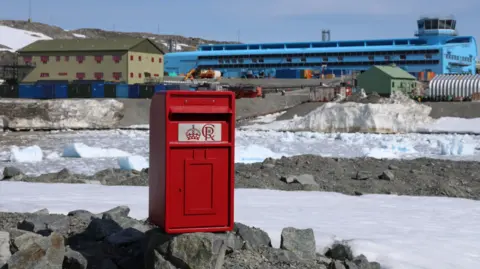 BAS/Jake Martin
BAS/Jake MartinJane Rumble, HM Commissioner for the British Antarctic Territory said: "Maintaining a postal service in the British Antarctic Territory is far more than a symbolic gesture.
"It reinforces Britain's presence and heritage in Antarctica and provides a vital link to the wider world."
Follow Cambridgeshire news on BBC Sounds, Facebook, Instagram and X.